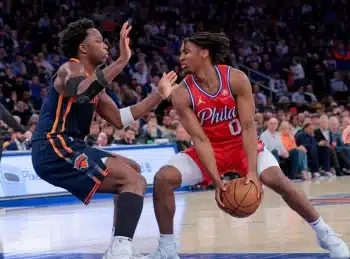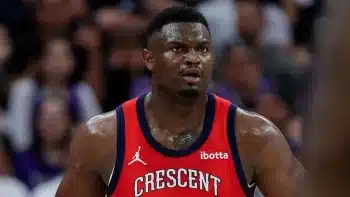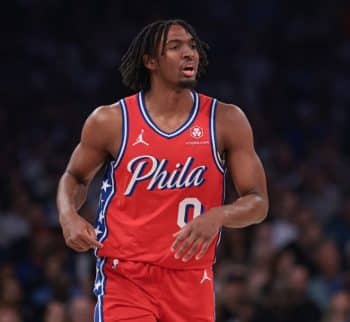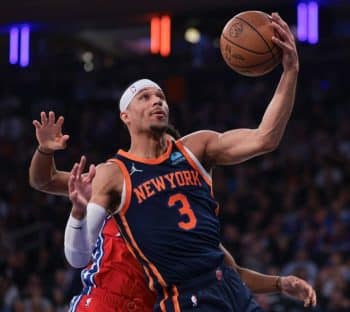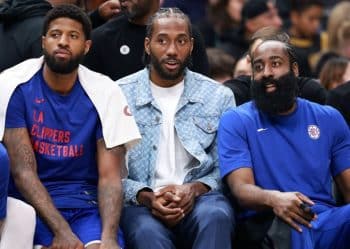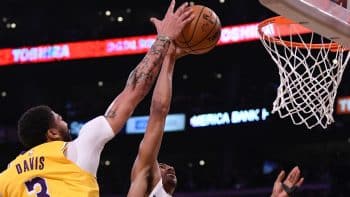NBA
Minnesota Timberwolves 2018-19 NBA Season Preview
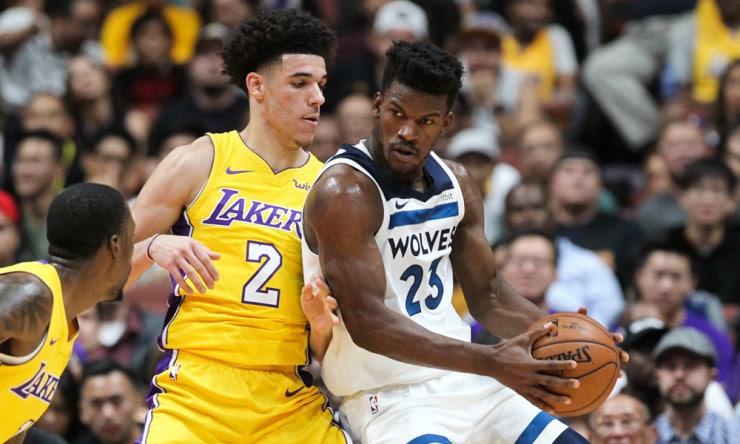
The Timberwolves enter this season with a lot to look forward to, coming off a weirdly successful 2017-18 season. Its franchise player, Karl-Anthony Towns should continue to mature and develop. Jimmy Butler is still in tow as the team’s most dependable star on both sides of the court. Andrew Wiggins has yet to realize his full potential, but still possesses incredible upside. Coach Tom Thibodeau’s assumed desire to reconstruct his 2010-11 Bulls team is mildly entertaining – so much so that some in the media have taken to calling the team the Timberbulls – but what’s really interesting is that the 2017-18 Wolves team were a subpar defensive unit despite being coached by a defensive guru. What’s even more surprising is that the team was successful with that style of play. So much so that it entered its February 24th contest against the Rockets in fourth place in the loaded Western Conference – a game in which Butler was injured, forcing him to miss the next 17 games and do serious damage to its playoff standings. Still, the Wolves talent wouldn’t allow them to implode entirely. The team ended the season with 47-wins and the eighth seed in the playoffs.
But problems exist for the Timberwolves. Can the team overcome the hostility between Butler, Towns and Wiggins? Can Jeff Teague and Tyus Jones continue to lead the team from the point guard position? Will Andrew Wiggins lock in defensively and become the star he was projected to be? And will Thibodeau be able to develop a deeper rotation or will be continue overwhelming his stars with tremendous workloads in the 2018-19 season?
FIVE GUYS THINK…
The Minnesota Timberwolves have so much talent and so many issues, unfortunately. The biggest issue, of course, is the internal discord between Jimmy Butler and Karl-Anthony Towns. If Tom Thibodeau can get his star players on the same page, this team could be one of the better Western Conference teams this season. If things fall apart early on, things could get ugly. I want to be optimistic and project that the key players on the roster will put the team first and focus on making a deep postseason run. However, I get the sense that this ongoing situation has gone too far and cannot be fully resolved at this point. I hope I am wrong, but only time will tell.
5th Place – Northwest Division
– Jesse Blancarte
As Tom Thibodeau continues his attempt to recreate his old Bulls roster and guys from the current group bicker somewhat publicly, it’s been a weird summer in Minnesota. This group clearly has the talent to be a playoff team in the West, and maybe even a top-four seed if everything breaks right and they get some internal development. But it’s hard to shake the feeling that despite that, this locker room feels primed for an implosion that sees them fall well short of the level their talent suggests they should attain. Butler’s renewed health along with the development of Karl-Anthony Towns will be two of the biggest factors, but so will the relationship between stars who have rumored to not exactly see eye to eye. Butler’s impending free agency in 2019 also looms large here.
4th Place – Northwest Division
– Ben Dowsett
Whatever optimism there was headed into last fall has gradually faded away a short year later. The Timberwolves are an enigma. They have a stud All-Star big man in Karl-Anthony Towns, a no-nonsense All-Star swingman in Jimmy Butler and steady veteran starters like Jeff Teague and Taj Gibson. Entering the first year of his five-year maximum contract extension signed in October 2017, Andrew Wiggins has to bring forth better production than he did last season. Chances are after a run with Butler for a full season, he might have a better feel for that role. However, with the Northwest Division in high competition, Minnesota could find itself on the short end of the stick.
4th Place – Northwest Division
– Spencer Davies
It might be time to declare that we jumped the gun on the Timberwolves. For the past few years, they’ve been hyped as the team of the future. Once they added Jimmy Butler, it seemed like their potential would finally be tapped. They may have made the playoffs last season, but the red flags definitely manifested themselves. Nobody appears to be happy. Butler appears ready to skip town. Thibs appears to not have learned his lesson from Chicago. The Timberwolves should be back in the hunt this year, but they are in a very competitive division within an even more competitive conference. If the discord is legit, it’s hard seeing them returning to the postseason.
5th Place – Northwest Division
– Matt John
We’ll see… that’s the only way you can honestly look at this Timberwolves team. On paper they should emerge as an elite team in the NBA. They have two bona fide All-Stars in Jimmy Butler and Karl-Anthony Towns, and if Andrew Wiggins can find that next gear they should have three. The problem is the noise about the young guys and Butler is very real, and while Tom Thibodeau is a solid head coach, we’re seeing that the coach in charge of everything model isn’t working, so we’ll see. Too much is being made of the TimberBulls thing because adding quality veterans that the coach knows and trusts is a common thing, regardless of where they played. The real question for the Wolves is can their Big Three play like a Big Three and not three high level guys trying to do their own thing? The Wolves could be special, they have some special players, but as we’ve seen elsewhere, having good guys doesn’t always equate to success. Especially when egos and contrasting needs and wants factor in.
5th Place – Northwest Division
– Steve Kyler
TOP OF THE LIST
Top Offensive Player: Karl-Anthony Towns
The Wolves have a number of strong offensive players, but none with as many gifts as Towns. Towns fits the unicorn mold as a seven-footer who can shoot from deep, punish opponents in the post, pass the ball and run the court. Towns is a mismatch for opponents nearly every night. He posted a PER of 24.9 last season, with 21.3 points, 12.3 rebounds and 1.9 blocks per game. While his scoring dipped four points per game last season, he saw increased efficiency in his already strong three-point and free throw shooting. Further, Towns decreased his turnovers per game from 2.7 to 1.9.
The Timberwolves would love to lock Towns up long term, which they can do soon if they agree to a contract extension prior to October 15. Towns is eligible for a five year max extension worth between $158 and $190 million. Will Towns sign the extension this late in the offseason? Will he and the Wolves agree on a shorter contract, which puts pressure on the team to get creative? Or might he wait until next offseason to make a decision? Only time will tell.
Top Defensive Player: Jimmy Butler
The Minnesota Timberwolves are among the few NBA franchises whose best defender is also the team’s leader and best player. Fortunately for the Wolves, the 2018 All-NBA defender is a maniacal worker who is incredibly dedicated to his conditioning and his craft. The Wolves are also fortunate that Butler’s defensive workload doesn’t affect his ability to contribute offensively. In fact, Butler led the Wolves in scoring last season with 22.2 points per game. He also tallied a personal best in steals per game (2.0) while regularly guarding the opposing team’s best guard or wing.
But last season was the first since his rookie year that Butler failed to play in at least 65 games. Butler proved that his knee was healthy following a February 2018 meniscus tear, but is the grind of carrying such a heavy workload on both sides of the court beginning to result in unsustainable fatigue? And will last season’s missed games prove to be the rule now and into the future or the exception to it?
Top Playmaker: Jeff Teague
By default, a team with as much infighting as the Wolves must have an effective playmaker to spread the floor and distribute the ball. Fortunately for the Wolves, Teague is a veteran who is used to sharing the ball with multiple starts. Remember, Teague was the starting point guard for the Atlanta Hawks teams, which featured Al Horford, Josh Smith and Joe Johnson – all of whom were legitimate scoring threats in the early 2010s.
Teague might not be a vocal leader like Chris Paul, but he is capable facilitator. He averaged 14.2 points and 7.0 assists per game last year while captaining the Wolves offense. And despite the team’s internal struggles, he fed his three main offensive weapons the rock, with Butler, Towns and Wiggins averaging 22.2, 21.3 and 17.7 points per game, respectively. If Teague can continue to play as reliably as he did last season, the point guard position looks to be in good hands for now.
Top Clutch Player: Andrew Wiggins
While this may seem slightly counterintuitive – after all, the word on Wiggins is that he has developed less through this point of his career than many had hoped – Wiggins actually has the stats to back it up. Believe it or not, Wiggins is the only member of the Timberwolves to hit a buzzer beater last season. But he didn’t win only one game with his heroics. He hit two buzzer beaters in 2017-18: a three-pointer on October 22 against the Thunder and an 18-footer on January 24 against Phoenix. Does this mean he has Mamba blood coursing through his veins? Not exactly. But it does mean that when asked to come through in the clutch, he can do so with the game on the line.
The Unheralded Player: Taj Gibson
The majority of the Wolves roster is easily classifiable as a star, former star, role player or rookie. And then there is Taj Gibson. Team President Thibodeau overpaid the veteran with a two-year, $28 million dollar deal beause Head Coach Thibodeau values Gibson’s on-court contributions. And it’s not Gibson’s fault he was offered a lucrative contract. Besides, he registered an above average PER of 15.4 last season. He put up 12.2 points and 7.1 rebounds per game, which represent the second best scoring and rebounding outputs of his career. And he even set a single-season team record, shooting 57-percent from the field.
But it’s important to remember that Gibson’s biggest contributions are harder to measure. Yes, he can score when needed. In fact, he scored 16 or more points in 23 games. But he was also the Wolves best post defender, and possibly their most versatile one, too. He covered an array of all-star-quality talent from James Harden to Nikola Jokic. Gibson is a good shot-contester. He was actually the twenty-second bes shot contester in the league last season. He also works his tail off and is a good locker room presence for a team that needs a positive influence. Most importantly, he impacts the game without being featured in the offense. But can Gibson impact remain as strong as he enters his tenth season? If he can, look for Gibson to log heavy minutes and make nightly contributions.
Best New Addition: Josh Okogie
Josh Okogie played two seasons at Georgia Tech, where he developed nicely. The 6’4” guard has elite athleticism that will likely carry him early in his career while he acclimates to the NBA game. He is a leaper who can run the court effectively on both offense and defense. He has numerous highlight-worthy chase-down blocks, for which he was aided by his freakish 7’0” wingspan. His energy and motor will be a valuable asset for a team that is lacking in both youth and depth.
Okogie’s peers think highly of his athleticism, too. He was rated the second most athletic rookie by the 2018 rookie class in their recent survey with NBA.com, which also named him second-runner-up in the best defender category. Okogie would be wise to make nice with Jimmy Butler and study his off-the-court procedures given their similar skill sets. Nothing is guaranteed – especially from a rookie – but Okogie should be a foundational building block if he’s willing to put in the requisite work.
– Drew Maresca
WHO WE LIKE
1. Keita Bates-Diop
Nabbing an impact player in the second round of the draft is always a cause for celebration. While doubts exist around most second-rounders, most of them are centered on a 2017 stress fracture in his left leg. But the 2018 rookie class seems to be fairly confident in Bates-Diop’s abilities. Through the above-mentioned survey, they named Bates-Diop as the biggest steal of the draft after watching him average 8.3 rebounds and 1.3 blocks per game in summer league action.
Bates-Diop has a relatively polished two-way game. The2017 Big Ten Player of the Year has a good touch. He is 6’8” wing with a 7’3” wingspan, which should allow him to develop into a versatile rim protector who can switch onto almost anyone on the court. The Timberwolves are thin up front and can benefit greatly from Bates-Diop, especially if he can mature quickly and improve his willingness to engage defensively on the low block
2. Tyus Jones
Tyus Jones stat line doesn’t come off as terribly impressive. Through 82 games in 2017-18, Jones averaged only 5.1 points and 2.8 assists per game., and was a mediocre three-point shooter at .349 from deep. But upon closer inspection, the Timberwolves’ fourth-year guard looks like he could be a keeper.
The team played better with Jones on the court in his 17.9 minutes per game than it did while he was on the bench. With Jones, the Timberwolves were 5.3 points per 100 possessions better than their opponents, and only .4 points per possession better while he was on the bench. Further, the team’s four starters plus Jones in place of Teague was actually 23.6 points better per 100 possessions than opponents. – albeit in only 261 minutes action. Much of this success stems from the fact that Jones had a low usage rate, and Towns, Butler and Wiggins took more shot attempts with Jones stewarding the team instead of Teague. Further, Jones turned the ball over at a low rate and contributed positively to the team’s defensive efforts. But those are difficult stats to ignore.
Jones opportunities should grow dramatically in the near future, too. The Wolves unofficially parted ways with guard Jamal Crawford after his contract expired following this past season. Crawford accounted for 20.7 minutes per game of the team’s available playing time for guards. It is unlikely that all of those minutes go to Jones, but the NBA is a production-oriented league. If Jones continues to produce, he will earn more playing time and, therefore, more opportunity to prove himself.
3. Andrew Wiggins
Wiggins is an interesting case. He hasn’t lived up to the sky-high expectations he’s been shouldering since entering the league as the next sure thing. But he did average 17.7 points per game last season as the team’s third option, not too shabby for an disappointment, And considering he is only 23, he still has substantial upside.
Wiggins regressed last season, partially due to the presence of Jimmy Butler and the fact that they play similar roles on offense. Butler is the more efficient of the two, but Wiggins natural talent might be greater. If he can figure out how to remain engaged for longer periods of time, his efficiency should improve. Further, if he embraces the challenge of becoming a lockdown defender – a challenge he is perfectly capable of succeeding at – he will receive additional accolades for being a true two-way player, much like Butler himself. And the Wolves will certainly need that level of production from its only committed star this season and beyond.
4. Derrick Rose
Despite the injuries and the dramatic fall from grace, Derrick Rose is still a big name in the basketball world. He is incredibly polarizing: loved by many, hated by others. Regardless of what you think of him, Rose can still contribute, albeit in a lesser capacity than he once did.
Rose should not be inserted into the starting lineup, nor should he be relied on to play too many minutes on a regular basis. But last we saw, he can still accelerate and finish around the rim better than most NBA players. He actually averaged 21.5 points per 36 minutes in the team’s five-game playoff series against the Houston Rockets in 2018. He can enter the game and prop up an otherwise stagnant offense for a short period of time. Assuming realistic expectations are in place, Rose can be an effective piece of a competing team – so long as he remains healthy.
– Drew Maresca
STRENGTHS
Superstars are traditionally viewed as foundational pieces for NBA teams. In the modern NBA, a team needs more than one superstar to be competitive. The way teams rank players is subjective, but its generally thought to be better to have more widely-considered great players than not. Sports Illustrated recently published its top 100 player rankings, and the Timberwolves’s Butler, Towns and Wiggins all ranked in the top 100 at 10, 19 and 74, respectively. They all complement each other nicely. They are all athletic and versatile. At 7’0”, 6’8” and 6’8”, they boast a good amount of size and length. Sure, Butler and Wiggins are a bit redundant. But if they can get on the same page, they are the closest thing to a present-day Michael and Scottie.
On paper, the team should be competitive with most teams in the league. They kept most of their talented players and added in two serviceable rookies. The roster should have no problem propelling the Wolves back into the playoffs, but unfortunately the games are not decided on paper.
– Drew Maresca
WEAKNESSES
The Minnesota Timberwolves are top heavy. We’ve established that the team is built around its three core stars. Towns and Wiggins are both young. Butler is 29, which means he is likely in the middle of his prime. Beyond those three there is very little youth on the roster, discounting the addition of the two rookies. Their point guards are Jeff Teague (30 years old), Tyus Jones (22) and Derrick Rose (29). Its forwards include Gibson (33), Anthony Tolliver (33) and Luol Deng (33). And its only serviceable backup center is Gorgui Dieng (28), an athletic, but limited, player. The Wolves do not have a backup shooting guard other than rookie Josh Okogie.
Coach Thibodeau’s strategy of relying on his starters will be tested this season. Hopefully it holds up for at least one more year. If not, the Wolves will need to rethink its philosophy on the fly.
– Drew Maresca
THE BURNING QUESTION:
Can Minnesota keep its core together?
The Minnesota Timberwolves find themselves in a precarious situation. On the one hand, the Wolves just completed its first winning season since 2004-05, ultimately posting its best season in years. And two of its franchise players, Karl-Anthony Towns and Andrew Wiggins are only 22 and 23 years old, respectively. The Wolves should theoretically be in great shape to continue improving this season.
On the other hand, the team enters the 2018-19 season with drama surrounding its core. The Wolves’ most productive player – Jimmy Butler – has taken offense to the casual approach of its other two superstars. According to Joe Cowley of the Chicago Sun-Times, Butler is all but fed up with the nonchalant attitude of his younger teammates, especially Karl-Anthony Towns. Further, Sean Deveney of The Sporting News reported last season that Butler had problems with Wiggins, his work ethic and his approach on the defensive end of the floor.
Unfortunately for the Wolves, Wiggins is the only one of the three to be signed to a long-term deal at $146.5 million dollars. Towns hasn’t yet accepted the contract extension offered to him in July. The opportunity to extend Towns evaporates as of 6 pm EST on October 15. Further, Butler becomes a free agent following the 2018-19 season. Unfortunately, Minnesota gave up a lot of value to pry Butler from Chicago last summer, and yet it seems as though the Wolves’ relationship with Butler might be irreparable – especially considering his rumored desire to pair up with Kyrie Irving.
Minnesota can go in one of two very different directions: it can re-sign Towns – and try to sign Butler – and continue to build around its existing core, or it can lose one or both of its soon-to-be free agent stars. This season and next offseason carry massive implications for the franchise. The three stars do not have to become friends with one another, but they need to co-exist on the court for the Wolves to be successful.
– Drew Maresca
